Sony A900 Full-Frame: Hands-On Preview
by Wesley Fink on September 12, 2008 12:00 AM EST- Posted in
- Digital Camera
Full-Frame, 24.6MP, and SteadyShot Integrated IS
The A900 is the first Sony DSLR to feature a full-frame sensor. The sensor is approximately the size of a frame of 35mm film, which is 24x36mm.
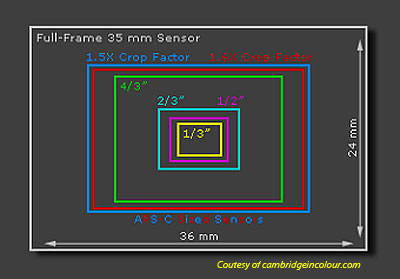
Most digital cameras today use a sensor closer to APS-C size. As a result, lenses mounted on APS-C DSLRs behave as if they are 150% to 200% longer than the marked focal length. Other Sony DSLR cameras, like the A700, also feature a 23.5x15.6mm APS-C sensor.
In the computer world, increasingly smaller traces mean higher density, more transistors, and generally better and faster performance. However, the digital sensor is not a digital device; it is an analog device that gathers light and turns it into a digital signal. Sensors are the reverse of digital electronics in that larger is almost always better in sensors, with everything else equal. More details on how digital sensors actually work can be found in The Digital Sensor.
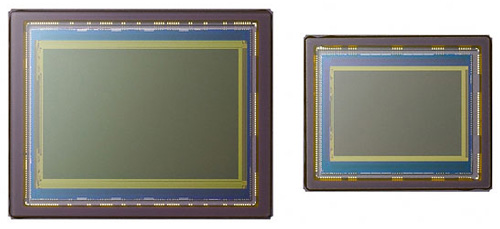
| DSLR Sensor Comparison | ||||
| Camera | Effective Sensor Resolution | Sensor Dimensions and Area |
% of Full-Frame | Sensor Density (MP/cm2) |
| Olympus E-520/E-3 | 10 | 13.5x18 2.43 cm2 |
28.10% | 4 |
| Canon XSi | 12.2 | 14.8x22.2 3.28 cm2 |
38.00% | 3.7 |
| Sony A350 | 14.2 | 15.8x23.6 3.72 cm2 |
42.90% | 3.8 |
| Pentax K20D | 14.6 | 15.6x23.4 3.65 cm2 |
42.20% | 4 |
| Canon 50D | 15.1 | 14.9x22.3 3.32 cm2 |
38.40% | 4.5 |
| Sony A700, Nikon D300, Nikon D90 | 12.3 | 15x23.5 3.66 cm2 |
42.40% | 3.3 |
| Nikon D700/Nikon D3 | 12.1 | 24x36 8.64 cm2 |
100% | 1.4 |
| Canon 5D | 12.7 | 24x36 8.64 cm2 |
100% | 1.5 |
| Canon 1Ds Mark III | 21.1 | 24x36 8.64 cm2 |
100% | 2.4 |
| Sony A900 | 24.6 | 24x35.9 8.61 cm2 |
100% | 2.9 |
The last column in the chart is the one that tells the story most accurately, however. Here the effective sensor resolution is divided by the sensor area to yield a sensor density. The lower the density, the larger the individual pixel size, and the more data that pixel can gather - all else being equal. There are a few surprises here, such as the Sony A350 being essentially the same density as the Canon XSi, and the new Canon 50D having the highest density of any current DSLR camera.
The last column does put into perspective the true potential of the full-frame sensor and shed some light on the true meaning of Sony's 24.6MP A900 sensor. At 2.9MP per cm2, the A900 still exhibits a lower density and theoretically better high ISO performance that any current APS-C DSLR. This is very much at odds with the ridiculous claims many on the web are making about Sony going too high in resolution on the A900. In fact, sensor density on the A900 is lower than the 10MP Canon 40D, which is 3.1.
The point is that any issues Sony may be found to have with noise are not the result of pixels being "too small". All else being equal the high ISO noise should be at least as good as an 8 to 10MP Canon sensor. Where the Sony does suffer is in comparison to sensor density of other full-frame sensors. In that metric the Sony has twice the pixels per cm2 of a Nikon D3/D700 and Canon 5D, and keeping up in high ISO performance with those cameras would be quite a feat.
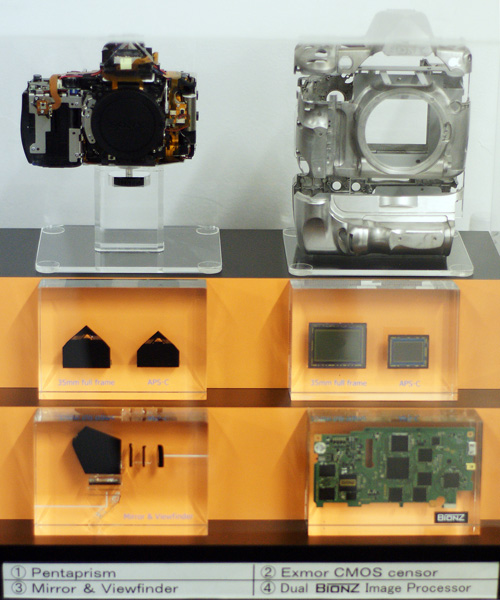
Moving a digital SLR camera to full-frame involves a lot more than just the sensor, however. Everything is bigger, heavier, and more difficult to accomplish. You can clearly see some of those challenges in this Sony case comparing sensors, pentaprisms, the microprocessor to move the huge increase in data (dual BIONZ), and the motors to control the in-camera image stabilization (IS). Rumors were rampant for months that Sony just could not get their signature SteadyShot IS to work in full-frame, which would have been a major failing had it turned out to be true. Now that we have used the A900 hands-on we can report that SteadyShot is definitely working as it should, and Sony still claims a 2.5 to 4.0 stop improvement in hand-holdability in the full-frame A900.
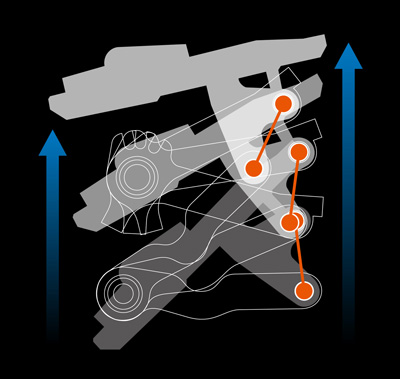
To accomplish this Sony employed a parallel-link to move instead of flip the mirror. This reduced vibration substantially to reduce the demands on SteadyShot. It also had the benefit of allowing a shorter front to back dimension while still utilizing a full-frame mirror.
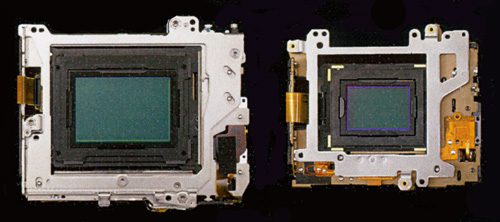
The second innovation was the sensor motors themselves. Since SteadyShot is controlling heavier components in even greater motion than APS-C, the motors required a 50% increase in output. Amazingly, the motors were beefed up, twice as many pixels are being captured and processed with dual BIONSZ processors, and with the same NP-FM5000H battery used in the A700, A350, A300, and A200 they extended the expected battery life in the A900 to 850 shots. Even if you're predisposed to hate Sony because you are a loyal Canon fan, you have to admire the engineering that went into solving many of these challenges.










53 Comments
View All Comments
sprockkets - Saturday, September 13, 2008 - link
Flash that Makes L Brackets Obsolete - Fortunes have been made with L brackets for pro cameras that enable shooting flash vertical with the flash also rotated 90 degrees. When you see the new Sony HVL-F58AM flash, you'll wonder why Sony - or you, or anyone else - didn't think of it sooner. The flash head turns smoothly in a 90 degree arc as one of its movements - aligning the flash perfectly for portrait mode. Goodbye L bracket.Sorry, quote funtion wouldn't work. Why is this an issue? Flashes for the longest time do something really easy to bounce or flash vertically in portrait mode. It's called they rotate horizontally. The only advantage here I suppose is that the back display is now easier to read facing up. Am I missing something here?
Maxington - Monday, September 15, 2008 - link
I was wondering the same thing about the Sony flash, exactly what is so special about it?I can do ceiling bounce flash holding the camera in portrait with my Pentax 540 flash, and that's been out for years.
What is this Sony flash doing that has everyone so excited?
randomlinh - Sunday, September 14, 2008 - link
I was thinking the same... this moves the flash a little closer in line with the lens.. but l brackets still have one huge advantage... it RAISES the flash up, which can be quite beneficial in itself.Crafty Spiker - Saturday, September 13, 2008 - link
Regardless of the product - do you really want to "vote" for Sony?melgross - Friday, September 12, 2008 - link
It's interesting that both Canon's 5D, and Nikon's D700 cameras are considered to be, even by their manufacturers, advanced amateur or semi-pro bodies, but at the same price level, the Sony 900 is considered to be professional, ala the Canon 1Ds, 1D, and Nikon D3.Sorry, this camera isn't built like those pro bodies from Canon and Nikon.
While pro's certainly use the 5D, and D700, they also use the 40D and the D300.
So, are those now pro bodies as well?
Sensor size doesn't determine whether a body is pro, and really, neither does weather sealing.
The 1Ds 1D, and D3 are certainly the most rugged bodies on the market, nothing else approaches them in this.
chiew - Sunday, September 14, 2008 - link
Sony has no weather sealed lenses...I doubt pros who shoot in adverse conditions will want a Sony until it is proven.Wesley Fink - Saturday, September 13, 2008 - link
The Canon 5D and Nikon D700 have 95% wiewfinders. So do the D300 and 40D. The Nikon D3, Canon 1Ds MkIII, AND Sony A900 all have 100% viewfinders. That is certainly one measure of a Pro camera.In comparing the build quality of the A900 to my D3 I did not find the A900 lacking. Of course the test of time is what matters most in evaluating build quality and it will take a while to see if the build is as rugged as it appears.
I assumed the grip would be an Achilles heel since the other Pro models have a built-in grip. However, the A900 grip uses the same magnesium alloy shell and sealing used on the a900. Still, an integrated grip would certainly be better sealed almost by definition. Frankly I prefer a grip I can leave at home if I choose. The true Pro models that fit your criteria are all a pain to lug around in the field. That's why my D4 stays at home sometimes and the D700 goes with me.
In the end I have no doubt the Sony is as well constructed as the other cameras you judge as Pro. I do, however, have reservations about a shutter that is only rated for 100,000 actuations. That is very low for a camera to be considered Pro, and is much more typical of semi-Pro or Advanced prosumer models.
melgross - Wednesday, September 17, 2008 - link
Big deal. Over the years, the Nikon F series had a 100% viewfinder. That didn't prevent Canon from knocking it off it;s top spot, even though Canon didn't consider that to be important.In fact, for many years, a 100% viewfinder was considered to be a negative. When we shot transparencies, the mount covered the millimeter around the outside edge of the slide, making what you saw no more than about 96% of the total. Using a 100% viewfinder often caused the mount to hide the edge of what you saw anyway.
Nowadays, it;s true, that doesn't matter, but 2 to 5% of the viewfinders outside edges is of no real noticeable importance if its less than the full frame. The problem would be the other way around.
I think the shutter is far more important in telling us what this camera is intended for than whatever else we can see from the outside. Can't judge a camera by its shell. Even the 5D II now has a 150,000 cycle shutter.
Lord 666 - Saturday, September 13, 2008 - link
The D300 has a 100% viewfinder. However, at $3000 for the D700, they could have easily used the same from D3... but more than likely did not to protect sales of D3.http://www.nikonusa.com/Find-Your-Nikon/Product/Di...">http://www.nikonusa.com/Find-Your-Nikon/Product/Di...
Wesley Fink - Saturday, September 13, 2008 - link
You are correct, the D300 does have a 100% finder. Mea Culpa.